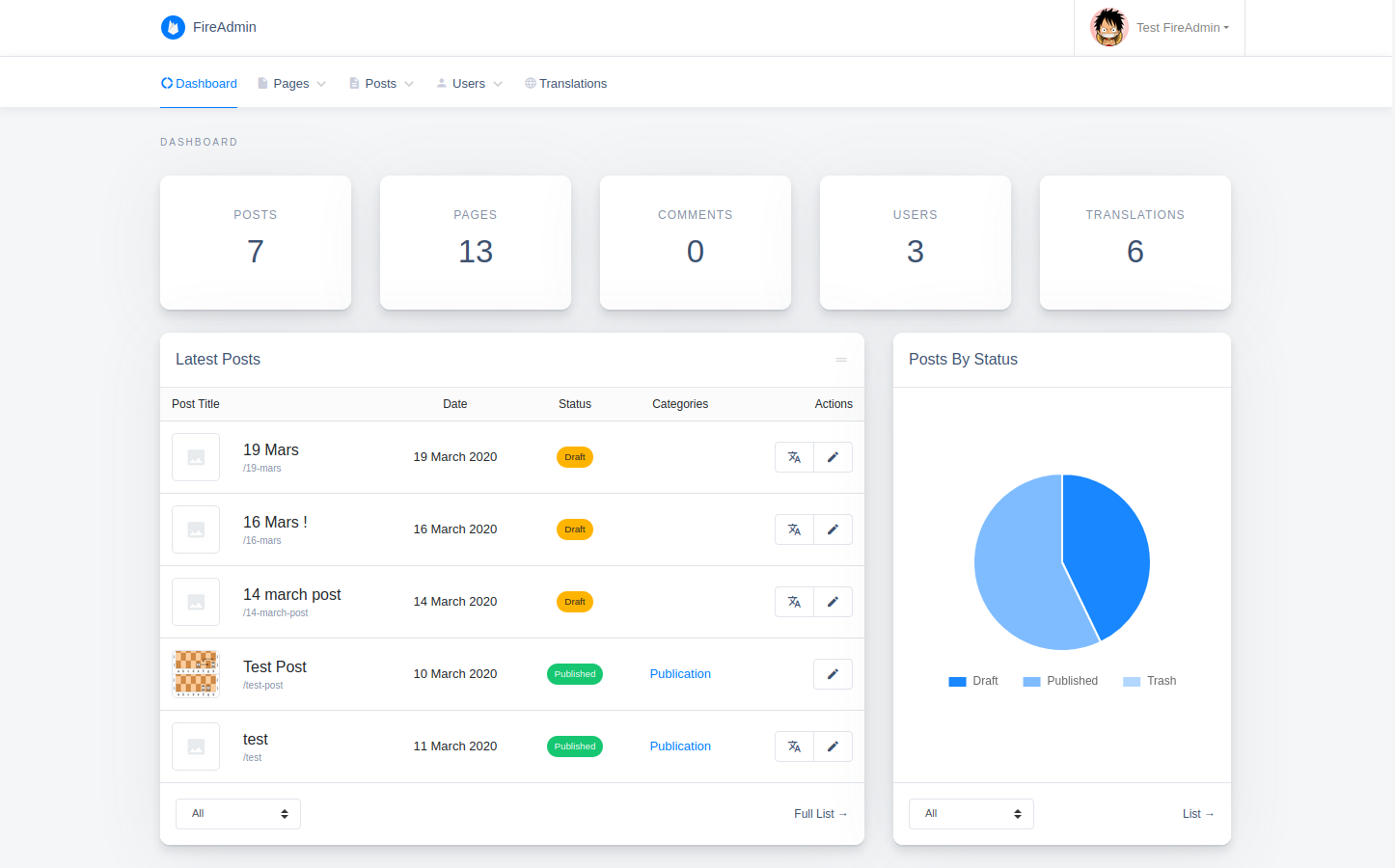ng-fire-admin
v0.0.3
Published
A mini headless CMS around Angular & Firebase.
Maintainers
Readme
FireAdmin
A minimalistic headless CMS around Angular & Firebase.

Demo
Features
- Simple & minimalistic
- Customizable
- Responsive
- Internationalization ready
- Easy/automated updates (via npm)
ToDo
- [ ] Menus handler
- [ ] Password reset feature
- [ ] Posts comments
- [ ] Posts custom fields
Installation
npm install --save ng-fire-adminUsage
It's recommended to use a multi-project workspace with basically 2 main applications (one for the frontend part & the other for the backend) to avoid any potential conflicts, then apply the following changes on your backend app:
ng new my-workspace --createApplication="false"
cd my-workspace
ng generate application backend --defaults --routing=true
// you can add the frontend app the same way
npm install --save ng-fire-admin1. Setup your firebase project:
Start by adding a new project in your firebase console.
Enable Authentication by email & password.
Add a database to your project.
2. Add your firebase configuration in environment.ts:
export const environment = {
production: false,
+ firebase: {
+ apiKey: "<API_KEY>",
+ authDomain: "<PROJECT_ID>.firebaseapp.com",
+ databaseURL: "https://<DATABASE_NAME>.firebaseio.com",
+ projectId: "<PROJECT_ID>",
+ storageBucket: "<BUCKET>.appspot.com",
+ messagingSenderId: "<SENDER_ID>",
+ appId: "<APP_ID>"
+ }
};3. Register the FireAdminModule in a module, for example app module:
import { BrowserModule } from '@angular/platform-browser';
import { NgModule } from '@angular/core';
import { AppRoutingModule } from './app-routing.module';
import { AppComponent } from './app.component';
+ import { FireAdminModule } from 'ng-fire-admin';
+ import { environment } from '../environments/environment';
@NgModule({
declarations: [AppComponent],
imports: [
BrowserModule,
AppRoutingModule,
+ FireAdminModule.initialize(environment.firebase)
],
providers: [],
bootstrap: [AppComponent]
})
export class AppModule {}4. Setup a simple routing as below:
import { NgModule } from '@angular/core';
import { Routes, RouterModule } from '@angular/router';
const routes: Routes = [
+ {
+ path: 'admin',
+ loadChildren: () => import('ng-fire-admin').then(m => m.FireAdminModule)
+ },
+ {
+ path: '**',
+ redirectTo: 'admin'
+ }
];
@NgModule({
imports: [RouterModule.forRoot(routes)],
exports: [RouterModule]
})
export class AppRoutingModule { }5. Edit your main component template (generally app.component.html) & keep only the <router-outlet></router-outlet> line:
+ <router-outlet></router-outlet>6. Add the following styles & scripts entries to angular.json:
"assets": [
"projects/backend/src/favicon.ico",
"projects/backend/src/assets"
],
"styles": [
"projects/backend/src/styles.css",
+ "node_modules/@fortawesome/fontawesome-free/css/all.min.css",
+ "node_modules/material-icons-font/material-icons-font.css",
+ "node_modules/bootstrap/dist/css/bootstrap.min.css",
+ "node_modules/datatables.net-responsive-dt/css/responsive.dataTables.min.css",
+ "node_modules/quill/dist/quill.snow.css"
],
"scripts": [
+ "node_modules/jquery/dist/jquery.min.js",
+ "node_modules/popper.js/dist/umd/popper.min.js",
+ "node_modules/bootstrap/dist/js/bootstrap.min.js",
+ "node_modules/datatables.net/js/jquery.dataTables.min.js",
+ "node_modules/datatables.net-responsive-dt/js/responsive.dataTables.min.js",
+ "node_modules/chart.js/dist/Chart.min.js",
+ "node_modules/shards-ui/dist/js/shards.min.js",
+ "node_modules/quill/dist/quill.min.js"
]7. You may also need to add the following lines to polyfills.ts:
// Add global to window, assigning the value of window itself.
+ (window as any).global = window;8. In order to protect your database & storage data, you must set the following rules in your firebase console:
Firestore Database rules:
rules_version = '2';
service cloud.firestore {
match /databases/{database}/documents {
match /{collection}/{document}/{path=**} {
allow read: if canRead(collection, document);
allow write: if canWrite(collection, document);
}
function canRead(collection, document) {
return isAccessible(collection, document) || isAdmin();
}
function canWrite(collection, document) {
return registrationEnabled(collection) || isAdmin() || (
isEditor() && collection != 'config' && isAccessible(collection, document)
);
}
function isAccessible(collection, document) {
return collection != 'users' || isOwner(document);
}
function isSignedIn() {
return request.auth != null;
}
function hasRole(role) {
return isSignedIn() && get(/databases/$(database)/documents/users/$(request.auth.uid)).data.role == role;
}
function isAdmin() {
return hasRole('admin');
}
function isEditor() {
return hasRole('editor');
}
function isOwner(ownerId) {
return isSignedIn() && request.auth.uid == ownerId;
}
function registrationEnabled(collection) {
return collection == 'users' && (
!exists(/databases/$(database)/documents/config/registration) ||
get(/databases/$(database)/documents/config/registration).data.enabled
);
}
}
} rules_version = '2';
service cloud.firestore {
match /databases/{database}/documents {
match /{collection}/{document=**} {
allow read: if collection != 'users' || request.auth != null;
allow write: if request.auth != null;
}
}
}Storage rules:
rules_version = '2';
service firebase.storage {
match /b/{bucket}/o {
match /{allPaths=**} {
allow read;
allow write: if request.auth != null;
}
}
}9. Launch your project using ng serve.
That's it :tada:, enjoy your ready to use backend app!
Build
Run ng build to build the project. The build artifacts will be stored in the dist/ directory.
Publishing
After building your library with ng build, go to the dist folder cd dist/fire-admin and run npm publish.
Credits
Firebase icon by Icons8.
License
This project is licensed under the MIT license.




